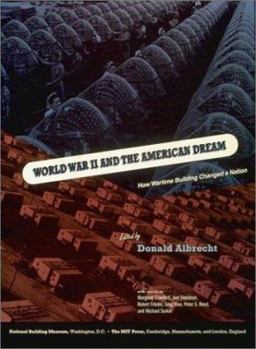World War II and the American Dream: How Wartime Building Changed a Nation
Select Format
Select Condition 
Book Overview
with essays by Peter S. Reed, Robert Friedel, Margaret Crawford, Greg Hise, Joel Davidson, and Michael Sorkin Among the legacies of World War II was a massive building program on a scale that America had not seen before and has not seen since. The war effort created thousands of factories, homes, even entire cities throughout the country. Many of these structures still stand, the physical evidence of an unprecedented ability to harness the power and resources of a people. The complex legacy of this most notable period in our nation's history is discussed from a different perspective by each contributor. Peter S. Reed, Associate Curator of the Department of Architecture and Design at the Museum of Modern Art, details the rise of modern architecture during the war -- housing designs that used the latest ideas in prefabricated construction methods, lightweight materials, innovative technologies, and a corporate and institutional aesthetic that helped popularize modernism as the appropriate image of American industrial might and corporate success. Robert Friedel, Professor of History at the University of Maryland, documents the development of new materials, especially plastics, and discusses techniques for employing traditional materials in novel ways. Margaret Crawford, Chair of the History and Theory of Architecture Program at the Southern California Institute of Architecture, explores the struggle of women and blacks for public housing. Greg Hise, Assistant Professor in the School of Urban and Regional Planning at the University of Southern California, considers how the construction of large-scale residential communities near defense plants prefigured postwar suburbia. Joel Davidson, historian of the "World War II and the American Dream" exhibition, analyzes the impact of the war's building program on the postwar military-industrial complex. Finally, Michael Sorkin, architect and writer, explores the migration of certain values and aesthetics from the necessities of war to the choices of peace. Among these are images of speed, camouflage, ruin, totalization, and flight. Copublished with The National Building Museum, Washington, D.C.
Format:Paperback
Language:English
ISBN:0262510839
ISBN13:9780262510837
Release Date:April 1995
Publisher:MIT Press (MA)
Length:330 Pages
Weight:0.65 lbs.
Dimensions:0.8" x 7.8" x 10.2"
Customer Reviews
2 ratings
Worl War II and the American Dream
Published by Thriftbooks.com User , 15 years ago
This is text-and-photo book covers an essential period that is little understood nowadays: how the United States was turned into a war machine. One only wishes that it was longer, especially since there is plenty of white space. Readers will learn not only more about the homefront in 1941-1945 but also the postwar period. But pinning the book to "the American Dream" is a marketing stretch. The people were either too busy or needed to put the dream on hold, but after the Depression years the energizing of an entire nation at least made millions believe that "the American Dream" would be possible.
brilliant research and documentation--a design necessity
Published by Thriftbooks.com User , 25 years ago
Albrecht is a master historian and curator. I have never seen a more thorough or loving chronology of the various experimental building technologies that flourished directly after WWII.This is essential reading for architects, industrial designers and the general public looking for ways to make sense of the built environment after the war.






